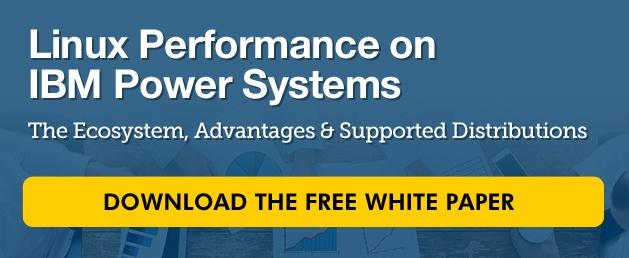The cloud is ever-expanding. With each passing year, the technology keeps growing by leaps and bounds, fundamentally changing the way we build new apps and deliver services.
Right now, the de facto standard for public and private cloud platforms is OpenStack. When you pair the way OpenStack easily embraces and integrates new features with the high processing speeds of the new IBM Power Enterprise Systems for the cloud, companies are well positioned to take advantage of the latest industry trends in cloud computing.
Here are 5 examples of how this change is already happening.
Enterprise Workloads Shifting to the Cloud
According to Right Scale, 17% of enterprise companies each have over 1,000 virtual machines (VM) in the public cloud. Businesses are finding the limits of application silos. They are discovering the benefits of an integrated, open source approach, as well as the gains that can be made with greater user control. They are looking for the technology, software and applications that will help them continue to grow in the cloud.
IBM Power Systems servers with OpenStack assist enterprise businesses with this paradigm shift. IBM Cloud PowerVC Manager provides a self-service portal that allows users to quickly request cloud services. In addition, VMs are reliably deployed with approval policies to maintain control over the provisioning of cloud resources.
When looking at the time it takes to commission, implement, and configure cloud services, that time is measured in hours. Traditional hardware systems could take days, if not weeks. IT departments also do not have to spend their time and resources on maintenance issues, which allows them to focus on critical business applications and generating new streams of revenue.
The cloud is scalable to any business need, and with OpenStack, software doesn’t have to be changed every time there’s a need to scale up or down. Furthermore, with OpenStack Newton, upgrades are non-events, with no downtime required. All these factors play a significant role in the current growth of cloud-based, enterprise workloads.
The Hybrid Cloud Is Becoming the Top Choice
A hybrid cloud is a blend of a company’s public cloud, private cloud, and its own dedicated servers. A hybrid cloud utilizing OpenStack brings these resources into the same ecosystem.
IBM Power Systems’ OpenStack-based PowerVC management with vRealize combines management and integration of Power-based VMs into a single orchestration platform for seamless operation. Users gain vast access to cloud resources to test new capabilities and technologies quickly. In addition, by having the right solution for the right job and assigning a specific workload to the proper resource, companies can get to market faster without huge upfront costs.
The Widespread Use of Core Containers and Docker
With the OpenStack Magnum project debuting in 2015, a new leader in core container efforts emerged. Magnum allows companies to create clusters with specific resources assigned to them, while also provisioning one of the orchestration technologies onto the cluster.
With Magnum running inside a Newton platform, operators can run multiple types of container orchestration on the same cloud, including Docker. With IBM Power Systems’ IBM Power Linux and IBM z/Linux, Docker is now easily ported into the system to compose, build, ship, and run distributed applications. In fact, with the capabilities of IBM Power Systems and Docker, operators can now get 10,000 containers on a single system.
The Growth of DevOps in Cloud Computing
DevOps and the cloud have emerged as essential parts of an enterprise business’s IT strategy. As a culture founded on supporting collaboration and communication across development and operations, DevOps has only been empowered by the cloud and cloud-native applications. An enterprise company can now stay relevant by capitalizing on the speed of innovation that DevOps provides while keeping costs under control and managing risk and compliance.
With IBM Power Systems’ support of cloud environments—particularly private and hybrid clouds—and IBM UrbanCode—a tool for automating application deployments—IBM’s approach to DevOps allows businesses to reduce the time to integrate customer feedback.
OpenStack gives engineers the speed and the tools to deal with uncertainties. With its inclusion in the DevOp ecosystem, businesses can now better meet customer demands and achieve fast development cycles for improved quality.
As cited on an IBM white paper regarding IBM Power Systems and DevOps for the hybrid cloud, the use of IBM UrbanCode has demonstrated a 482% return on investment, 97% reduction in cost per application, and 75% faster app deployment times.
Disaster Recovery with the Cloud
Almost every year, security is cited as the top challenge of the cloud. With more and more workloads living in the cloud, it is only projected to remain at the top of the list. However, when it comes to disaster recovery, many companies still rely on on-premise hardware. If that backup appliance is affected, a company’s backups can be wiped out in an instant.
IBM Power Systems’ disaster recovery as a service (DRaaS) provides continuous replication of a company’s critical applications, data, infrastructure, and systems. With DRaaS, IT administrators can bring lost infrastructure back in minutes without the need to set up new servers, download data, or re-install apps. By having the network environment virtualized on the cloud, the environment can be booted up directly in the cloud. This eliminates not only downtime for employees, but also the huge costs that can result from an operational shutdown or the failure to deliver to your customers’ expectations.
